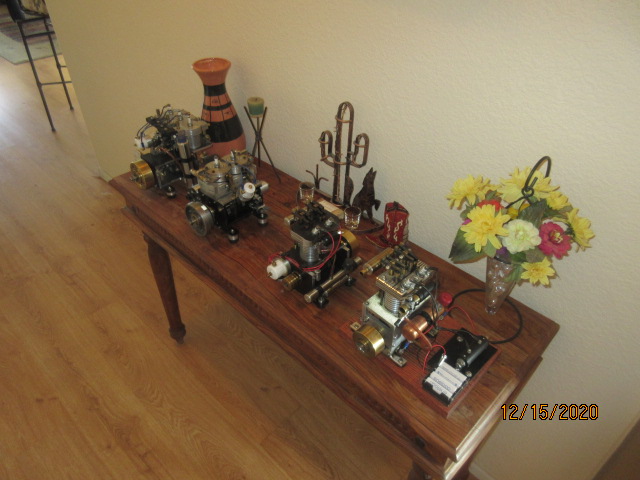Tin Falcon
Well-Known Member
- Joined
- Jul 9, 2007
- Messages
- 7,207
- Reaction score
- 789
What Engines are best for a first build ?
How to select a plan set .
By Tin Falcon
How to select a plan set .
By Tin Falcon
One of the most popular questions on this board is people wanting recommendations for there first model engine.
Here are some of my thoughts on the subject.
1) the engine
a ) simple single cylinder design like a wobbler
b)or a McCabe runner.
c) HMEM EZ
d) many too numerous to mention.
2) size or scale :
IMHO 3/8 to 1/2 bore is probably a good starting point.
Tiny engines require more air pressure and are more subject to friction problems.
larger engines require bigger machines and require more material
double the size and the amount of material increases by 8 times.
3) materials :
6061 aluminum can be used for most engine parts. It is a common material easy to machine light weight and relatively inexpensive.
7075 aluminum nicer to machine but generally more expensive. a bit harder than 6061.
12L14 Steel easy to machine the standard of machineability for steel. Tend to rust so need attention or paint. good for fly wheels and crank disks.etc.
Drill rod aka silver steel can be heat treated and hardened good for crank shafts and pins.
360 Brass easy to machine looks great can be used for most parts nice for fly wheels but expensive. in comparison to other metals.
Cast iron good to machine tends to be dirty an powdery needs good housekeeping to protect the operator and machine from the dust. good for cylinders and flywheels can be used for most parts . recommend painting except on running surfaces and fly wheel rims.
Bronze good for cylinders , liners fly wheels bearings etc. Again can be used for most engine parts.
Avoid running fits of like metals. use softer metals on parts that are more easily machined and replaced.
Use known materials mystery metal can cause headaches.
4) Plan sets there are many on the internet both in metric and imperial.
some plans are simply one page with all the info. easy to make a copy and put near the machine in the shop . Other plan sets have a page per part. this can help focus on the one part leaves room for notes and calculations and are generally more readable.
try to select a plan set that makes sense to you. if you do not understand the way a part is designed and made it could be difficult.
Some plan sets come with directions and some do not.
5) variations on a theme and creativity. lets look at the fly wheel for example there are several ways of making a fly wheel. one can start with a casting. or a slice of round bar or a piece of bar or plate stock and machine it from a solid piece . The second way is build up a fly wheel from smaller pieces then weld or solder together. There are many ways to shape the spokes. do not be afraid to use design concepts from more than one plan set on on model. Also a fly wheel can be made from brass , bronze, steel cast iron or aluminum or even plastic.
6) Dimensions, tolerances and fits. There are some dimensions on a model that are critical.Some are not. Also many models will have fractional dimensions. Machine tools and precision measuring instruments measure in thousandths or ten thousands of an inch or in decimal millimeters. so some math and conversion will have to happen.
dimension: the specified size listed on the print expressed in linear length, diameter of a hole or round cross section or the radius of an arc.
tolerance The specified allowable deviation from a given dimension. for example the normal tolerance for the length of a model base given as 4 1/2 inches or 4.5 inches would be +- 1/64 or .015 in in reality the outside dimension of a base,flywheel or engine frame or block is not critical . even the tolerance on a cylinder to piston fit is not critical as long as they fit together well. So if the specified bore is say .5000 + .0005 -.0000 then the piston should be .4990 to .4995 . but what if your half in bore turns out ten thousands over. that is way to much tolerance for a bore diameter. but if you make the piston to fit the bore no problem.
Also if press fitting a shaft into a fly wheel a bit of knurling will snug up a loose fit.
On an oscillator try to keep the layout for the the holes on the engine block as accurate as you can also the location of the crank pin is important as is the size of your air steam ports. these are the critical dimensions that make the valving work. One you learn the important dimensions for the model you can relax if one of the unimportant ones are off a bit from the print.
Hope this helps those looking to start in this great hobby . do not be afraid to ask questions. and experienced guys feel free to post the plans of your first engine. or a link to the vendor as appropriate.
Tin Falcon
Here are some resources :
McCabe Runner plans
LMS Oscillator
John-tom.com Steam plans
Prof. McCabe's web page steam plans
Western Kentucky University wobbler



















































![DreamPlan Home Design and Landscaping Software Free for Windows [PC Download]](https://m.media-amazon.com/images/I/51kvZH2dVLL._SL500_.jpg)



![MeshMagic 3D Free 3D Modeling Software [Download]](https://m.media-amazon.com/images/I/B1U+p8ewjGS._SL500_.png)







